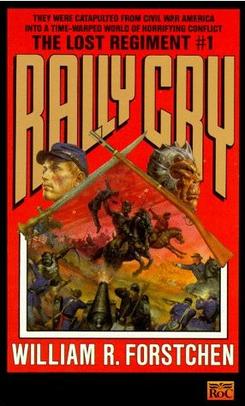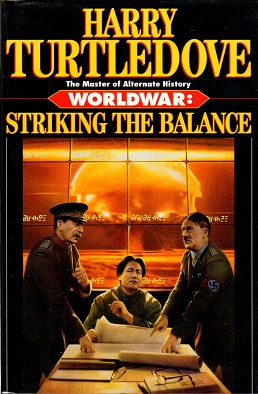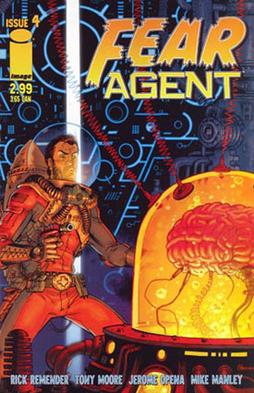Plot
The plot revolves around a Union Army regiment and an artillery battery from the American Civil War, which got transported to an alien world. The 35th Maine Infantry Regiment and the 44th New York Light Artillery Battery travelled to a different world using a ship that emerged from a mysterious electrical storm. The alien world was populated by descendants of medieval Russians (or "Rus"), who still lived at a medieval level of technology. They learned that there were various civilizations on this world made up of descendants of people from various eras of Earth's history.
The Union soldiers eventually discovered that the Russians had been hiding the existence of the Tugar from them. The Tugars were ten-foot-tall aliens with a culture and technology similar to that of the Mongols. They rode a never-ending circuit around the planet and subjugated the human population in their territory for food. The Tugars visited each human society once a generation and culled part of the population for food so that the humans stay docile, compliant and never advanced enough to challenge them. The Union men were horrified by this revelation and kill the Tugars advanced scouts. They supported a peasant rebellion against the Tugar-appointed lords and begin modernizing Russian society. When the Tugars arrived, they encountered a semi-modern army equipped with cannons and smoothbore muskets. In a hard-fought battle, the humans managed to prevail, weakening the Tugars forever.
The next several books take up the story a few years later. The Russians had begun to explore the possibilities of a union with the Romans who lived next to their territory and were spared from the Tugar depredation by the Russian victory. Meanwhile, they faced a renewed threat from the Merki, members of the same alien race as the Tugars. The Merki make the same circumnavigation of the globe as the Tugars do but in a zone further south. Once the Merki learn of the Tugar's weakening, they seek to take advantage of the Russians, realizing the disastrous effects that would come from an industrialized enemy. They seek to maintain their racial dominance over the humans through the annihilation of those who have learned the secrets of gunpowder and industrialization. The Merki are aided by a group of Union sailors who fled the Tugar war on the ship which brought the Unions to this world. In exchange for their survival, the humans help the Merki develop firearms and other technology. The Merki attack is more successful than the Tugar one and forces the humans to abandon the Russian territory in a scorched earth campaign, but eventually, they win with their use of trains.
Several years later, the expanding human alliance faces a new threat in the form of the Bantag. The Bantag are a horde from even further south. They are led by a member of their race who arrived from another world that has a late 20th-century level of technology. This alien, a soldier in his own world, assumes a messianic role among the Bantag and modernizes their society to equal, and even surpass that of the humans. He is familiar with atomic reactors as well as centerfire rifles. The Bantag scavenge engines from decaying cities abandoned by their people millennia ago and use them to power airplanes. The reader learns that the people of the Bantag had once been a technologically advanced star-faring race, visiting many different planets and seeding teleportation devices across them. The Bantag homeworld collapsed in a nuclear war but the teleportation devices remained sporadically active and ended up transporting various humans to the planet Vallenia (the location of the novel), though Vallenia was not the homeworld of the Tugar, Merki, and Bantag Hordes. Using their advanced technology, the Bantag attacked the Union, introducing steampunk tanks and 20th-century mortars to the world of Vallenia. However, the humans developed their own flying machines (mainly blimps and early Zeppelins) and organized a counterattack.
The final book in the series, Down to the Sea, takes place a generation after the arrival of the Unions. With the children of the original regiment members reaching adulthood, they face a new threat from across the southern sea, the Kazars, aliens who have an early 20th-century level of technology and who also have a selectively bred slave race of human assassins, called the Shiv.
35th Maine
The 35th Regiment, Maine Volunteer Infantry is a fictional volunteer regiment (Maine really raised 32 Infantry regiments) during the American Civil War in William Forstchen's The Lost Regiment series. (The regiment is based on Joshua Chamberlain's 20th Maine Infantry.)
Before the series Andrew Lawrence Keane is a lieutenant who assumed command when a superior officer was KIA at Antietam. Keane's leadership under the guidance of his sergeant, Hans Schuder, made them ripe for promotion as they progressed through Fredericksburg, Cold Harbor and Gettysburg.
At the start of the series, Keane is promoted to colonel after losing his arm at Gettysburg. Hans Schuder was recently promoted to sergeant major. In the world of Valennia, the 35th becomes essentially a vassal force to Boyar Ivor of the "Rus" people, who appear to be derived from early Russian peoples earlier transported to Valennia. When Ivor is overthrown, it becomes the core of the anti-Tugar resistance, with Keane filling as a military dictator. As time goes on, the men of the 35th are rapidly promoted to fill the officer corps of the Rus Army and train the Rus forces. When all hope seemed lost, the Rus broke ranks in the Tugar War, the 35th reformed and made a desperate last defense.
After the Tugar War, the 35th becomes the most respected regiment, on which the Army of Russia is centered. Analogous to the United States Military Academy at West Point, the 35th is the best that Rus has to offer and provides a place to train new officers for the Army of the Republic. Even some men from the original 35th remain in the regiment when they could otherwise be high-ranking officers.
Men from the original 35th include (in progress):
- Andrew Keane (Colonel)
- Hans Schuder (Sergeant Major)
- Barry (Sergeant)
- Tim Kindred
- Hank Petracci
- Chuck Ferguson
- Gates
- Vincent Hawthorne
- Jim Hinsen
- John Mina
- Emil Weiss (regimental surgeon)

United States Colored Troops (USCT) were Union Army regiments during the American Civil War that primarily comprised African Americans, with soldiers from other ethnic groups also serving in USCT units. Established in response to a demand for more units from Union Army commanders, by the end of the war in 1865 USCT regiments, which numbered 175 in total, constituted about one-tenth of the manpower of the army. Approximately 20% of USCT soldiers were killed in action or died of disease and other causes, a rate about 35% higher than that of white Union troops. Numerous USCT soldiers fought with distinction, with 16 receiving the Medal of Honor. The USCT regiments were precursors to the Buffalo Soldier units which fought in the American Indian Wars.

Joshua Lawrence Chamberlain was an American college professor from Maine who volunteered during the American Civil War to join the Union Army. He became a highly respected and decorated Union officer, reaching the rank of brigadier general. He is best known for his gallantry at the Battle of Gettysburg, for which he was awarded the Medal of Honor.

Strong Vincent was a lawyer who became famous as a U.S. Army officer during the American Civil War. He was mortally wounded while leading his brigade during the fighting at Little Round Top on the second day of the Battle of Gettysburg, and died five days later.

The 35th Infantry Division, formerly known as the 35th Division, is an infantry formation of the United States Army National Guard headquartered at Fort Leavenworth, Kansas.

Rally Cry is a science fiction novel by American writer William Forstchen, first published in 1990. It is the first book in Forstchen's Lost Regiment series. Its plot follows the Union Army's 35th Maine Volunteer Infantry and 44th New York Light Artillery as they board a transport ship, the Ogunquit, in City Point, Virginia, on January 2, 1865. Their mission is to take place in the amphibious assault of Fort Fisher, the Confederate fort defending Wilmington, North Carolina.

Worldwar: Striking the Balance is an alternate history novel by American writer Harry Turtledove. It is the fourth and final novel of the Worldwar tetralogy and the fourth installment in the extended Worldwar series, which includes the Colonization trilogy and the novel Homeward Bound.

The 1st Maine Infantry Regiment was an infantry regiment that served in the Union Army during the American Civil War. It was later re-activated in 1898 for the Spanish–American War, but did not serve overseas.

The 2nd Maine Infantry Regiment was a Union Army unit during the American Civil War. It was mustered in Bangor, Maine, for two years' service on May 28, 1861, and mustered out in the same place on June 9, 1863.

Fear Agent is an American science fiction comic book series written by Rick Remender with art by Tony Moore and Jerome Opena, who alternated on story arcs. The series was published by Dark Horse Comics from 2007 to 2018 and by Image Comics from 2005–2006 and currently from 2018.
The 7th Wisconsin Infantry Regiment was an infantry regiment that served in the Union Army during the American Civil War. It was a component of the famous Iron Brigade in the Army of the Potomac throughout the war.

The Battle of Ghazni took place in the city of Ghazni in central Afghanistan on Tuesday, July 23, 1839, during the First Anglo-Afghan War.

Out of the Dark is an alien invasion science fiction novel by David Weber released by Tor Books on September 28, 2010. It is an extended version of the short story of the same name published in the 2010 anthology Warriors edited by Gardner Dozois and George R. R. Martin. A sequel, titled Into the Light, was published more than a decade later in January 2021.

The 6th Maine Infantry Regiment was an infantry regiment that served in the Union Army during the American Civil War.

Walter Goodale Morrill was a Union Army officer in the American Civil War and a recipient of the U.S. military's highest decoration, the Medal of Honor, for his actions at the Second Battle of Rappahannock Station in November 1863. Also, Morrill's earlier actions in July 1863 at Gettysburg are considered essential for the famous Union victory on Little Round Top.
American Civil War alternate histories are alternate history fiction that focuses on the Civil War ending differently or not occurring. The American Civil War is a popular point of divergence in English-language alternate history fiction. The most common variants detail the victory and survival of the Confederate States. Less common variants include a Union victory under different circumstances from actual history, resulting in a different postwar situation; black American slaves freeing themselves by revolt without waiting for Lincoln's Emancipation Proclamation; a direct British and/or French intervention in the war; the survival of Lincoln during John Wilkes Booth's assassination attempt; a retelling of historical events with fantasy elements inserted; the Civil War never breaking out and a peaceful compromise being reached; and secret history tales. The point of divergence in such a story can be a "natural, realistic" event, such as one general making a different decision, or one sentry detecting an enemy invasion unlike in reality. It can also be an "unnatural" fantasy/science fiction plot device such as time travel, which usually takes the form of someone bringing modern weapons or hindsight knowledge into the past. Still another related variant is a scenario of a Civil War that breaks out at a different time from 1861 and under different circumstances.
The 30th Rifle Division was an infantry division of the Soviet Union, formed three times. The final full name of its first formation was the 30th Rifle Irkutsk Order of Lenin, three Orders of the Red Banner, Order of the Red Banner of Labour Division of the name of the Supreme Soviet of the RSFSR. After being redesignated the 55th Guards Rifle Division in December 1942, the Second Formation of the division was recreated at Rossosh in April 1943. The division was formed a third time in 1955.
The 17th Rifle Division was an infantry division of the Soviet Union's Red Army during World War II.

The 352nd Rifle Division started forming in August 1941, as a standard Red Army rifle division, at Bugulma in Tatarstan. When it entered the fighting it was assigned to the Western Front before Moscow, and it would remain in that Front for most of the war; when Western Front was dissolved the division went to one of its successor Fronts and served there until the last few weeks. It took part in the first Soviet winter counteroffensive, then played peripheral roles in the battles around the Rhzev salient, before advancing in the offensive that liberated Smolensk in the summer of 1943. After a series of frustrating attempts during the autumn and winter of 1943-44, the city of Orsha was finally liberated in the opening days of Operation Bagration, and the 352nd was recognized for its role in the battle. Soon after it was further decorated for its part in the liberation of Grodno. In the winter of 1945 the 352nd took part in the invasion of East Prussia and the capture of Königsberg, but in April it finally was swung off its very straightforward combat path when it and its 31st Army were transferred to 1st Ukrainian Front advancing into Czechoslovakia. Soon after the German surrender the division was slated as one of those to be disbanded in place in central Europe.
The 206th Rifle Division was twice formed as an infantry division of the Red Army, first as part of the prewar buildup of forces. Its first formation in March 1941 was based on the last prewar shtat for rifle divisions. When the German invasion began it was still organizing well away from the front near Krivoi Rog but was soon sent to the Kiev Fortified Sector where it eventually came under command of the 37th Army. It was deeply encircled by the German offensive in September and destroyed, but not officially stricken from the Soviet order of battle until late December.













